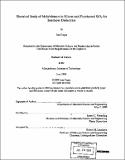| dc.contributor.advisor | Lionel C. Kimerling. | en_US |
| dc.contributor.author | Cagas, Jean (Cagas Quijano, Jean Allison), 1977- | en_US |
| dc.contributor.other | Massachusetts Institute of Technology. Dept. of Materials Science and Engineering. | en_US |
| dc.date.accessioned | 2005-08-22T19:16:09Z | |
| dc.date.available | 2005-08-22T19:16:09Z | |
| dc.date.copyright | 1999 | en_US |
| dc.date.issued | 1999 | en_US |
| dc.identifier.uri | http://hdl.handle.net/1721.1/9556 | |
| dc.description | Thesis (S.B.)--Massachusetts Institute of Technology, Dept. of Materials Science and Engineering, 1999. | en_US |
| dc.description | Includes bibliographical references (leaves 27-28). | en_US |
| dc.description.abstract | Molybdenum is unintentionally introduced into silicon at various points in semiconductor processing. This introduction is a concern because molybdenum introduces a deep level state into the forbidden gap of silicon, degrading minority carrier lifetime. In this project, DLTS was used to measure the concentration of electrically active molybdenum. Temperature dependence was investigated by varying annealing temperature and keeping annealing time constant, and time dependence was studied by performing rapid thermal anneals at 750°C and varying annealing time. DLTS spectra were generated and isothermal depth profiles of trap concentration were found using additional data from C-V measurements. For a rate window of 35 ms, the molybdenum peak occurred at 165K. The energy level of molybdenum was 0.3eV and the capture cross section was 5.5x10·16cm2. At high temperatures, the diffusion behavior of molybdenum exhibited a Gaussian profile. At low temperatures, however, the profiles exhibited an initial kick-out mechanism followed by normal diffusion. Fluorinated SiO2 is becoming an extremely important material for intermetal dielectrics. As integrated circuits are scaling down in size, the RC constant is becoming the bottleneck to faster circuit speeds. The addition of fluorine decreases the dielectric constant of SiO2 by decreasing the ionic and electronic polarizability of the entire structure. The addition of fluorine still has some detrimental effects, however, such as lower hardness and increased water adsorption. For this project, eight oxide films with varying fluorine content were studied. The dielectric constant K of each film was calculated with the saturation capacitance from C-V measurements, oxide thickness, and diameter. While all the observed values of K were lower than known values for pure SiO2, they did not exhibit a decreasing trend. Possibly, processing conditions might have had more of a dominant effect for such small differences in fluorine content. From changing C-V profiles and fluctuating saturation capacitance, it is suggested that there was movement of charge in the oxide layers. However, this was not consistent for all the films. | en_US |
| dc.description.statementofresponsibility | by Jean Cagas. | en_US |
| dc.format.extent | 28 leaves | en_US |
| dc.format.extent | 1678089 bytes | |
| dc.format.extent | 1677847 bytes | |
| dc.format.mimetype | application/pdf | |
| dc.format.mimetype | application/pdf | |
| dc.language.iso | eng | en_US |
| dc.publisher | Massachusetts Institute of Technology | en_US |
| dc.rights | M.I.T. theses are protected by copyright. They may be viewed from this source for any purpose, but reproduction or distribution in any format is prohibited without written permission. See provided URL for inquiries about permission. | en_US |
| dc.rights.uri | http://dspace.mit.edu/handle/1721.1/7582 | |
| dc.subject | Materials Science and Engineering. | en_US |
| dc.title | Electrical study of molybdenum in silicon and fluorinated SiO₂ for interlayer dielectrics | en_US |
| dc.type | Thesis | en_US |
| dc.description.degree | S.B. | en_US |
| dc.contributor.department | Massachusetts Institute of Technology. Department of Materials Science and Engineering | |
| dc.identifier.oclc | 43961068 | en_US |
